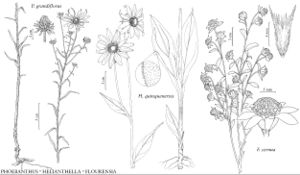Phoebanthus
Proc. Amer. Acad. Arts 51: 520. 1916.
| Taxon | Illustrator ⠉ | |
|---|---|---|
 | Phoebanthus grandiflorus Helianthella quinquenervis Flourensia cernua | Marjorie C. Leggitt Yevonn Wilson-Ramsey Barbara Alongi |
Perennials, 40–100+ cm (aerial stems from relatively slender, horizontal tubers). Stems erect, branched mostly distally (among heads, leafy). Leaves cauline; all opposite, or proximal opposite and distal alternate, or all alternate; sessile; blades (usually 1-nerved) linear-filiform or linear to linear-lanceolate, bases ± cuneate or rounded, margins entire (revolute), faces scabrous (adaxial) and sparsely hispid-scabrous, glanddotted as well. Heads radiate, borne singly or (2–6) in open, ± corymbiform arrays. Involucres hemispheric to campanulate, 10–20 mm diam. Phyllaries persistent, 20–40+ in 2–3+ series (green, subequal, herbaceous, strigillose to hispid). Receptacles convex, paleate (paleae tan, conduplicate, trilobed or tricuspidate). Ray-florets 10–20, neuter; corollas yellow (apices 2–4-lobed). Disc-florets 40–100+, bisexual, fertile; corollas yellow, tubes shorter than narrowly campanulate throats, lobes 5, triangular. Cypselae (purplish black) obpyramidal, slightly compressed; pappi 0, or persistent or fragile, of 1–2 lacerate scales (over cypsela shoulders) plus 0–6 lacerate or bristlelike shorter scales. x = 17.
Distribution
se United States
Discussion
Species 2 (2 in the flora).
Selected References
None.
Lower Taxa
Key
| 1 | Leaves linear to linear-lanceolate, the larger 3–7 mm wide; phyllaries appressed | Phoebanthus grandiflorus |
| 1 | Leaves linear-filiform, the larger 0.5–2 mm wide; phyllaries spreading | Phoebanthus tenuifolius |
"broader" is not a number.